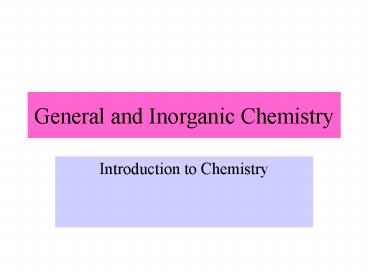General and Inorganic Chemistry - PowerPoint PPT Presentation
1 / 28
Title:
General and Inorganic Chemistry
Description:
General and Inorganic Chemistry Introduction to Chemistry What is Chemistry Chemistry is the study of chemicals; how properties depend on composition. – PowerPoint PPT presentation
Number of Views:2341
Avg rating:3.0/5.0
Title: General and Inorganic Chemistry
1
General and Inorganic Chemistry
- Introduction to Chemistry
2
What is Chemistry
- Chemistry is the study of chemicals how
properties depend on composition. What substances
are and how they change. - El Khemid - the transformation. Chemistry is
about changing substances into others. - What chemicals? First metals then cosmetics,
medicines, ceramics, glass making.
3
What did early chemists do?
- Identify, classify, describe Knowledge leads to
curiosity. - Rather than learn all substances seek underlying
patterns and theories that explain chemical
behavior. - Apply scientific method.
4
Apply scientific method.
- Observation vs interpretation
- Observation - with statement of certainty is a
fact - Laws - generalized observations
- Hypothesis to explain observations - predictions
- Experiment - Test hypothesis
- Theory - tested hypothesis
- Model- Combination of theories that form a
general explanation of wide variety of phenomenon
5
A Delicate Balance
- Science is different from art in that scientific
knowledge requires agreement first of the facts
and then of the theories. - There is a delicate balance between what is known
and what we think about what is known. - This is the idea of provisional truth we believe
our hypotheses but maintain a healthy skepticism.
6
Serendipity
- "Chance favors the prepared mind
- When asked what did you think when you saw the
bones of your hand on the screen in front of the
cathode ray tube? Roentgen replied I did not
think. I investigated.
7
How do we describe matter?
- Matter occupies space and has weight. (Actually
Mass, weight is the affect of gravity on mass). - Matter exists in three physical states.
- Solid
- Liquid
- Gas
8
Properties of Matter
- Physical properties Color, mp, bp, density,
index of refraction. Observation of these do not
change chemical composition. - Chemical properties Observation of these causes
a chemical change substances become other
substances. Reactivity with acids to liberate
carbons dioxide.
9
Physical properties
- Physical properties can be
- Extensive i.e. depend on amount of substance like
mass or volume - Intensive i.e. independent of amount like
temperature or pressure. - Some properties are qualitative others are
quantitative.
10
Quantitative properties.
- Measurements require a system of units
- SI- Systeme International
- Base units m, kg, s, K, mol
- Derived units Joule, liter, pascal
- Prefixes mega, kilo, deci, centi, milli, micro,
nano, pico
11
conversions
12
Energy
- Energy ability to do work
- Kinetic mv2/2
- Potential - chemical
- Conservation of energy. Heat and work transfer
energy
13
Temperature zeroeth law
- Heat is the flow of energy from a hot object to a
cold object. - Heat flows from regions of high temperature to
regions of low temperature. - Differentiate between heat which is energy flow
and temperature which gives the direction of flow.
14
Accuracy and Precision
- An Advil Ô Tablet was "weighed" on a digital
laboratory balance 22 times with the following
results
15
(No Transcript)
16
The normal distribution
mean 0.4586
17
mean 0.4586
?, Standard deviation
18
The normal distribution
67
95
19
(No Transcript)
20
Significant Figures
21
Every sample of a pure substance has the same
properties. In contrast the properties of
mixtures depend on the compostion of each sample
22
Mixtures can be separated into their pure
components
- Mixtures can be separated into their pure
components by physical means - Filtration
- Mechanical separation
- Distilation
- Dissolving
- Chromatography
23
Elements Compounds
- Elements can not be broken down into simpler
substances - Compounds can be chemically broken down into the
elements of which they are composed. - There are 108 elements known but 40 of these
compose 99.9 of all substances. - 10 elements compose 99 of the earths crust.
24
Ten elements compose 99 of the earths crust
25
Water
Earth
Fire
Air
26
Three quarters of the elements are metals
- Metals are
- Malleable
- Ductile
- Lustrous
- Conductors
- heat
- electricity
The chemical symbols for some metals are not the
same as the first letter of the English name for
the element Pb-lead W-tungsten K-potassium Cu-cop
per Fe-iron Hg-mercury Na-sodium Sn-tin
27
These non-metals are solids at room
temperature Arsenic-As Phosphorous-P
Sulfur-S Iodine-I Boron-B Selenium-Se
Carbon-C The rest are gases
28
The Law of Constant Composition
The relative amounts of each element in a
compound are always the same.
Mass percentage or percent composition
Mass of Element
X 100
Mass of compound
Fe 1.56 g S 0.9007g 2.47g
massFe 1.56/2.47 x100 63.5































